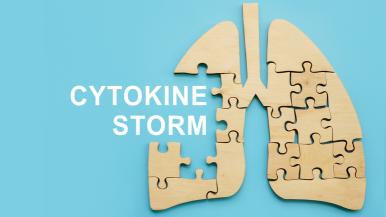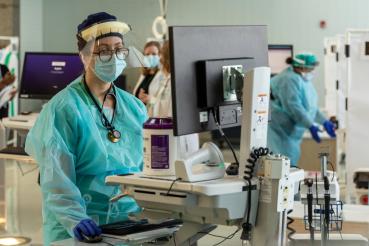Scientists have uncovered a new understanding of how COVID-19 causes severe multi-organ injury in some patients and the pathways to stopping the cytokine storms behind them, according to new research published today in the Journal of Clinical Investigation Insight. “The research inspires a paradigm shift in how we think about cytokine-storm related illness,” said RUSH nephrologist Sumant Chugh, MD, senior author of the article “Cytokine storm-based mechanisms for extra-pulmonary manifestations of SARS-CoV-2 infection.”
Using mouse models and creating a method for mirroring the levels of organ injury and inflammation that COVID-19 can cause, the researchers uncovered pathways to reducing that injury to vital organs.
COVID-19 is known to create a severe immune reaction in which the body releases too many cytokines into the blood too quickly. This response, called a cytokine storm, is at the root of the multiorgan injury, starting with the lungs, that leads to critical illness and death from SARS-CoV-2. Once this cytokine storm reaches beyond the lungs, it affects organs not directly infected by the virus, causing myocarditis, pericarditis, liver injury, acute kidney injury and acute glomerular injury in some patients.
The research model began years before the pandemic when Chugh, a nephrologist and physician scientist, and his team at the Glomerular Disease Therapeutics Laboratory at RUSH were studying why patients with certain types of kidney disease that was under control would relapse when they caught a cold. Having discovered a key genetic defect in these patients and having developed a way to mimic the cytokine storm caused by the common cold for a mouse-model of study, the research shifted to finding ways to replicate and study the inflammation from SARS-CoV-2 infections.
The research provides important insight on both COVID-19 and the common cold, Chugh said, including:
- Why some COVID-19 patients suffer such inflammatory illnesses as myocarditis, pericarditis, liver injury, proteinuria and acute kidney injury.
- The possibilities for treating severe COVID-19 disease with specific dual pathways to stopping the storm of inflammation (called cytokine depletion), rather than a single cytokine depletion, which current treatments have provided.
- How using a single cytokine depletion to treat COVID-19 may relieve mild to moderate manifestations of the infection in organs other than the lungs.
- Why patients with rare kidney diseases like minimal change disease and focal and segmental glomerulosclerosis become far more ill after a common cold infection and how that injury may be stopped.
“When the pandemic broke, we took a hard look at early data from COVID-19 patients admitted to the intensive care unit and used our prior experience replicating cytokine injury caused by the common cold to develop and test COVID-19 injury for our research,” Chugh said.
Rather than infecting the mice with the SARS-CoV-2 virus or with the common cold, the researchers developed a “cocktail” to replicate major components of the cytokine storm caused by those viruses, he said.
“At low doses, these COVID-19 cocktails had toxic effects on the filtering units of the kidney called glomeruli, and induced protein leakage in the urine. At higher doses, they affected the heart, liver and other parts of the kidney to induce myocarditis, pericarditis, liver injury and acute kidney injury.”
Researchers tested ways to deplete different types of cytokines, such as TNFα (tumor necrosis factor alpha) and many interleukins, and compared the effectiveness of depleting one type at a time compared to specific combinations of cytokines. They found that a strategy of depleting two cytokines was more effective, particularly if TNFα was one of the cytokines.
“Much of what we discovered will inspire new ways of treating complications of COVID-19 and other severe respiratory viral illnesses,” Chugh said. “There may be additional applications of this approach in developing animal models for long COVID syndrome.”




